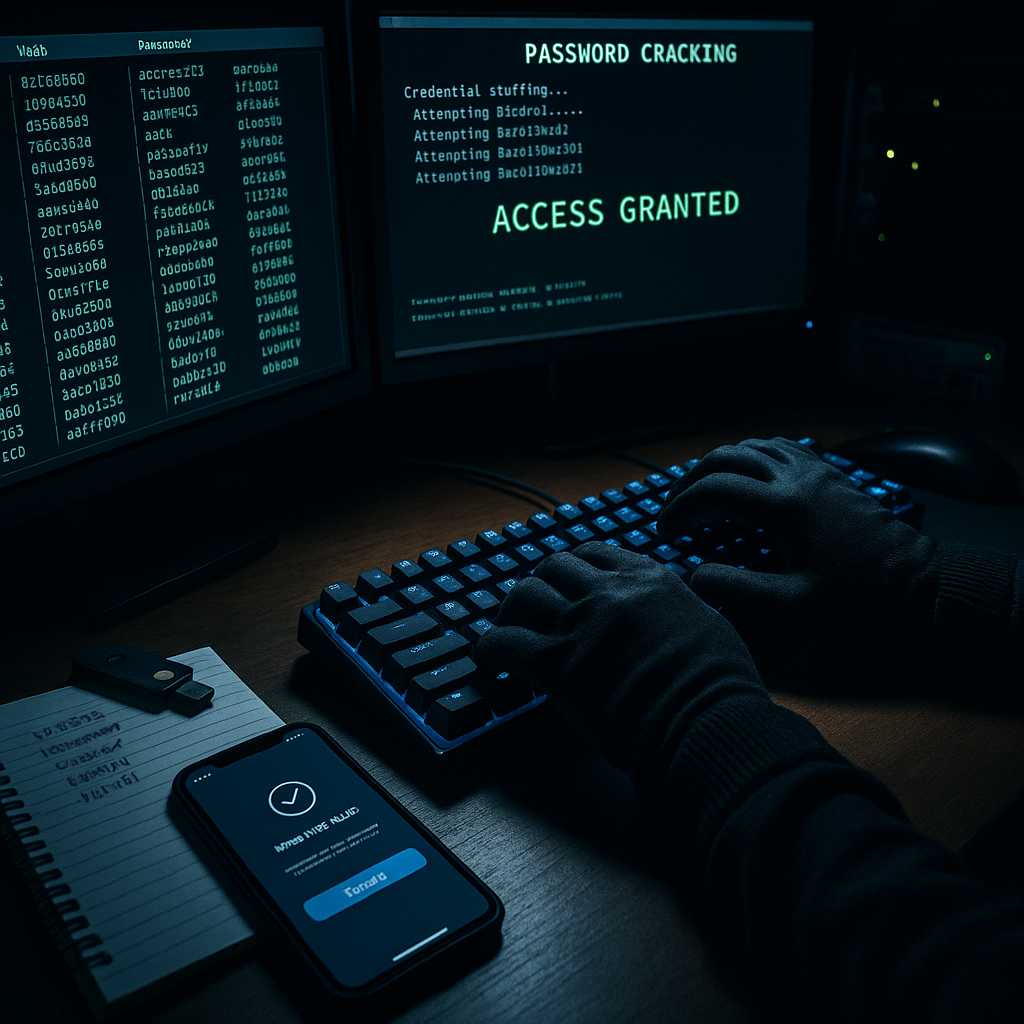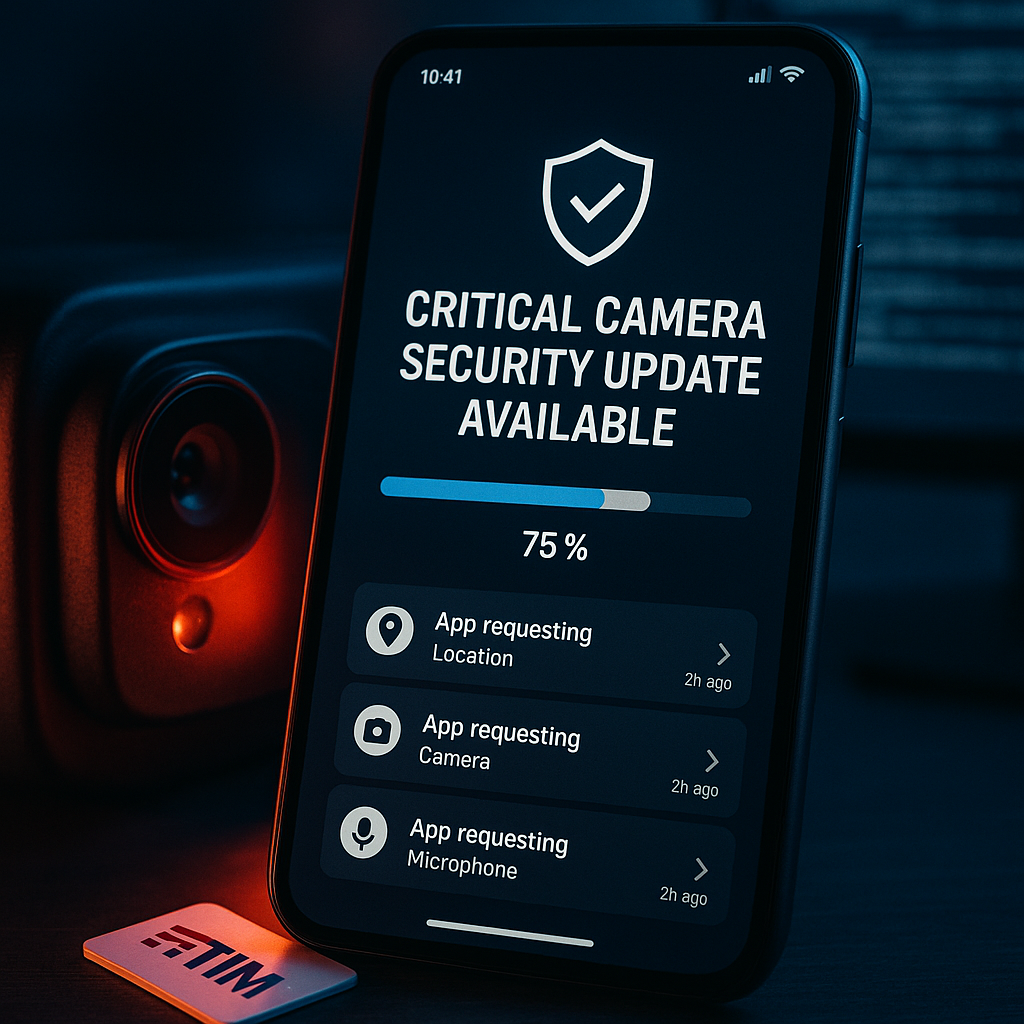Key Takeaways
- Hackers exploit predictable patterns that often go unnoticed. Most users unknowingly create passwords following familiar sequences or personal information. Cognitive biases and shortcuts influence these choices, making them easy targets for attackers armed with dictionary and brute-force techniques.
- The sophistication of password cracking tools is outpacing user habits. Attackers now employ advanced tactics like password spraying, pass-the-hash, and credential stuffing to compromise thousands of accounts quickly. Weak passwords, reused credentials, or even slightly modified ones are especially vulnerable in this environment.
- Stolen credentials often trigger domino-effect breaches. Once passwords are compromised, they are tested across multiple platforms in large-scale credential attacks, exploiting the widespread tendency to reuse passwords across sites and services. This frequently puts sensitivity data well beyond the initial account at risk.
- Multi-factor authentication (MFA) disrupts common attack strategies. By requiring a second factor of identification, MFA adds a crucial layer of protection. Even if an attacker gains your password through phishing or automated guessing, MFA typically blocks unauthorized access.
- Password managers eliminate human error and strengthen overall security. These tools generate unique, complex passwords for every account and store them securely. By removing the need to remember or write down passwords, they close the loopholes created by human habits and cognitive limitations.
- Social engineering overcomes technical barriers. Hackers increasingly rely on phishing, pretexting, and other manipulation tactics to trick users into revealing passwords, highlighting that strong psychological defenses are as critical as technical solutions in robust cybersecurity.
- True security arises from behavioral change, not just stronger passwords. The hidden insight is that defending against hacking requires more than complexity—it calls for overcoming cognitive biases and maintaining ongoing vigilance to prevent predictable, exploitable habits.
Arming yourself with knowledge of how attackers operate (and why users frequently fall into their traps) prepares you to build smarter, more resilient password habits. In the sections ahead, we break down each attack method and defense strategy, guiding you from reactive responses to proactive security.
Introduction
Passwords are still the frontline barriers protecting our digital identities, finances, and sensitive information. Yet, despite their critical role, many passwords are far weaker than users recognize. High-profile data breaches often trace back to common patterns or oversights that attackers skillfully exploit through increasingly sophisticated password hacking techniques, such as brute-force intrusions and coordinated credential-based attacks.
To understand password security in today’s landscape, you need more than a list of do’s and don’ts or the habit of occasionally changing your credentials. Modern attackers deploy a toolkit that includes password spraying, credential stuffing, social engineering, and more. All of these target not just technical loopholes but also the subtle psychological habits and shortcuts that shape our password choices. Discovering how these attacks actually work (and the strategies that truly safeguard your accounts) can transform your approach from simple precaution to active defense.
Common Password Attack Methods
Getting a handle on the risks begins with understanding how attackers systematically target weak passwords. Each method exploits predictability in human behavior or weaknesses in system design.
Un passo avanti. Sempre.
Unisciti al nostro canale Telegram per ricevere
aggiornamenti mirati, notizie selezionate e contenuti che fanno davvero la differenza.
Zero distrazioni, solo ciò che conta.
 Entra nel Canale
Entra nel Canale
Brute Force Attacks
Brute force attacks methodically try every possible combination of characters until the correct password is discovered. Advances in hardware and specialized cracking software allow even modest setups to test billions of combinations per second, making short or simple passwords especially susceptible.
A real-world example highlights the danger. In 2012, LinkedIn experienced a breach resulting in the theft of 164 million encrypted passwords. With the help of GPU-accelerated cracking tools, hackers managed to break 90% of these passwords within just three days. This incident underscores that even hashed passwords can be vulnerable if users don’t create complex enough passphrases.
Dictionary Attacks
Rather than trying every possible character, dictionary attacks employ curated wordlists filled with common passwords, phrases, and predictable variations. Because people often choose memorable passwords (think “password123” or “letmein”), these attacks remain highly effective.
Modern attackers enhance these lists with automated rules that:
- Substitute characters (for example, ‘a’ becomes ‘@’, ‘s’ becomes ‘$’)
- Add numbers or special characters to basic words
- String multiple dictionary words together
- Adjust capitalization and other simple changes
A NordPass study found that, even today, “password123” remains among the 20 most common passwords in use, highlighting the lasting impact of human tendencies on security.
Password Spraying
While brute force attacks hammer away at one account, password spraying flips that script. It uses a few common passwords across thousands of accounts. By limiting attempts per account, attackers dodge lockout policies and efficiently exploit systems where many users share similar weak passwords.
Noteworthy statistics:
- According to Microsoft, password spraying accounts for more than 30% of all account compromises.
- Even with a modest 1-2% success rate, attackers can gain access to a staggering number of accounts.
- Large organizations are particularly at risk due to standardized password policies and larger user bases.
cyber hygiene is crucial to help prevent such attacks by enforcing strong password habits and implementing layered security approaches.
Rainbow Table Attacks
Rainbow tables accelerate password cracking by storing massive lists of pre-computed hash values, trading storage space for speed. These attacks are especially effective against systems using unsalted hashes (where each password produces the same hash every time).
While defenders now commonly use salting to counteract rainbow tables, older legacy systems and poorly maintained sites remain vulnerable. The 2016 Dropbox breach is a prime example, where attackers leveraged rainbow tables to crack millions of SHA-1 hashed passwords. It’s a reminder that outdated practices continue to expose users to unnecessary risk.
Psychological Aspects of Password Creation
Technology alone doesn’t determine security; human psychology plays an equally important role. Password strengths and weaknesses often begin in the mind.
Cognitive Biases in Password Selection
People naturally gravitate toward passwords that are meaningful and easy to remember. This often leads to:
- Using personally significant details (like names and birthdays)
- Reusing passwords across different platforms
- Making only slight modifications, such as altering a single digit or character, when required to update passwords
Such behaviors are rooted in our brains’ preference for familiar and manageable patterns, as well as the mental burden of remembering many complex passwords. Unfortunately, these habits are precisely what attackers count on when building their cracking tools.
For a deeper dive into the psychology behind password choices and the formation of safer digital habits, see digital declutter approaches that emphasize intentional and secure technology use.
Pattern Recognition and Exploitation
Hackers keenly exploit the psychology behind password creation. They know to look for:
- Personal information such as family member names, anniversaries, or favorite places
- Simple keyboard paths (e.g., “qwerty” or “asdfgh”)
- Pop culture references, songs, or popular movies
- Words with emotional resonance for the user
A 2021 analysis found 73% of users relied on predictable patterns or personal information when generating passwords. This insight allows attackers to dramatically narrow the field of possible combinations, increasing their odds of success.
Un passo avanti. Sempre.
Unisciti al nostro canale Telegram per ricevere
aggiornamenti mirati, notizie selezionate e contenuti che fanno davvero la differenza.
Zero distrazioni, solo ciò che conta.
 Entra nel Canale
Entra nel Canale
Advanced Password Cracking Techniques
While traditional attacks focus on guessing or brute-forcing passwords, modern hackers also utilize advanced tactics to work around defenses altogether.
Pass-the-Hash Attacks
Pass-the-hash is an example of a sophisticated attack that skips guessing passwords entirely. Instead, attackers steal password hash values (unique representations of your password) from memory or network traffic. With the hash in hand, hackers can authenticate directly to systems (especially in Microsoft environments), enabling lateral movement across a network without ever learning the original password.
Typical steps in these attacks involve:
- Using tools like Mimikatz to extract NTLM hashes from memory or intercepted traffic
- Plugging these hashes into new sessions to impersonate legitimate users
- Bypassing password length or complexity requirements
Credential Stuffing
Credential stuffing automates the process of testing massive lists of stolen credentials against various online accounts and services. Because people tend to reuse passwords, attackers can easily compromise additional sites by leveraging usernames and passwords exposed in previous data leaks.
Modern attack infrastructure includes:
- Distributed proxy and botnet networks to avoid detection and throttle limits
- Automated tools capable of bypassing CAPTCHA and other security measures
- Sophisticated checkers that report valid login attempts across dozens of platforms
Even if success rates seem low (usually between 0.1% and 2%), the sheer scale of automation means attackers can still compromise thousands of accounts in a single campaign.
For advanced strategies that help address these and other threat vectors, consider reading about the latest password managers and their evolving features for cyber defense.
Effective Defense Strategies
Understanding attacker tactics is only the beginning. Real-world security demands proactive defenses built to counter both technical and psychological vulnerabilities.
Technical Controls
Strong technical frameworks protect against a wide array of threats:
- Establish and enforce strong password policies (minimum 12 characters, inclusion of numbers, symbols, and both upper- and lower-case letters)
- Deploy adaptive rate limiting to slow automated attack attempts without hindering legitimate users
- Use modern password hashing algorithms (such as Argon2 or bcrypt) with appropriate security factors to protect stored credentials
- Design account lockout policies that detect suspicious activity without inconveniencing users unnecessarily
These controls act as the foundation for a robust security posture, making it far more difficult for attackers to succeed.
Multi-Factor Authentication
Multi-factor authentication (MFA) stops many attacks before they begin. By adding a secondary method, such as a code sent to your phone, a hardware key, or a biometric scan, MFA ensures that stolen or guessed passwords alone are not sufficient for account access.
The benefits are clear:
- Organizations see account compromise rates drop by 99.9% after implementing MFA
- Fewer password-related support issues, saving time and reducing IT costs by up to 66%
- Enhanced compliance with industry and regulatory standards in finance, healthcare, and other sensitive fields
For step-by-step help in implementing multi-factor authentication across your most important accounts, check out this easy-to-follow tutorial.
Password Management Solutions
Password managers simplify and strengthen your security stance across all accounts. Their key advantages include:
- Generating high-entropy (complex and unique) passwords for every site or service
- Securely storing passwords in an encrypted vault, accessible on multiple devices
- Automating password changes and rotation, ensuring sets remain current and uncompromised
- Supporting secure password sharing for families or teams
- Integrating with single sign-on (SSO) and providing detailed audit logs for organizations
With a password manager, users no longer need to rely on memory or risky storage methods, dramatically reducing the likelihood of common missteps.
To compare tools and discover which password manager fits your needs and security goals, see this comprehensive guide.
Conclusion
Today’s password security landscape is shaped by a dynamic interplay of constantly evolving hacker tactics and deeply ingrained human behavior. Attackers exploit not just technological gaps with brute-force, dictionary, and advanced techniques, but also the cognitive patterns and shortcuts that make us predictable. As high-profile breaches demonstrate, a single weak or reused password can trigger far-reaching consequences, underscoring the urgent need for robust, multifaceted defenses.
The strongest defense is a blend of smart technical controls, vigilant user behavior, and the thoughtful adoption of best practices such as password managers and multi-factor authentication. Cultivating good security habits is no longer merely an IT rule; it is a shared responsibility empowering individuals and organizations alike. In a digital environment where speed and convenience compete with caution and security, your ability to recognize threats and adapt proactively will set you apart.
Looking ahead, password security will only grow more complex as attackers refine their methods and users integrate new technologies into daily life. Staying ahead means making security a priority, embracing change, and continually educating yourself and your community. The real competitive edge belongs to those who anticipate risks and invest in strong, user-focused defense strategies. This approach ensures that both personal and organizational assets remain protected now and into the future. Empower yourself to turn knowledge into action and maintain the upper hand in the ever-evolving world of cybersecurity.





Leave a Reply